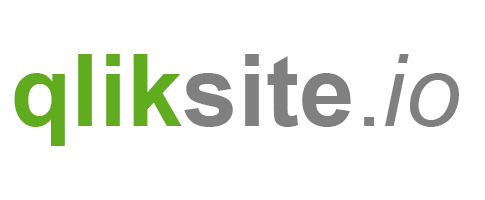If you have been following my activities for a while, you might have realized that I have recently stopped to publish on qlikblog.at and moved over to a new site called qliksite.io.
Since then I have received some questions why I took this decision. qlikblog.at was and is quite popular, so on the first view this seems to be a stupid decision.
If you are interested to understand what happened, continue to read, otherwise just enjoy the day.
qlikblog.at - So much 2000, äh WordPress
qlikblog.at is based on WordPress, which was fine and served my needs for some years. But over time I realized some problems:
- Actually I started to spend much more of my time in my favorite IDE, testing APIs, writing prototypes, documenting them a bit, publishing them on GitHub. That kind of work really drives me, just experimenting what's possible with several APIs; that's fun.
- But then the problem starts: Instead of just publishing the code and writing a README.md on GitHub I had to write about these projects a second time, just to publish them on my blog ... really boring. So I more and more ommited that work and focused on GitHub.
- I had new ideas how to publish and structure new content, but extending WordPress was hard. I am not really a big fan of PHP, therefore developing custom plugins annoyed me quite a lot, too much.
- Last but not least, I moved with my family from Austria to Germany, so a blog with a .at domain just felt wrong.
So all in all it was time to look for a new, a better solution.
Just pure HTML?
Since I started to develop web-based solutions back in 1994 - in the very early days of the Internet - my obvious thinking was to maybe just develop my own system which fits my needs.
But then I read more and more about static-site-generators. And starting to test some of those system I started to re-think, this approach just felt natural to me:
- Just having again the full power and freedom of Html & CSS just felt great.
- It felt a bit retro, but good.
- But can a bigger web-site really work without a CMS, doesn't this lead sooner or later to a lot of broken links?
- How can I integrate all those GitHub repos in a nice way?
I spent more and more time to investigate which static-site-generator might be a good fit to meet my needs:
- Jekyll is great, but I am not a Ruby guy and also didn't want to investigate too much time to learn.
- I wanted to have something available in the technologies I currently prefer: JavaScript and node.js
- So metalsmith was one of the next options, very nice and flexible, but it felt a bit limited. After writing a few plugins I realized that using metalsmith could result in a lot of coding work.
- Finally I ended up in following the great projects from Jon Schlinkert and Brian Woodward, working on verb, generate and especially assemble.
- When starting to use assemble they main contributors just started a complete re-write, so I decided to follow closely.
- It was hard to be patient (for over a year now) and wait until their complete re-write of these concepts finally took shape, but now we (or better said they) are there.
Using assemble
The current version of qliksite.io uses assemble in the background, but even more:
- It connects several GitHub repos and publishes them to a single site.
The Flow
So how does that work:
- First of all I can continue to work on my prototypes, tutorials and projects and GitHub, just as I ever did in the recent years.
- I just use Markdown to comment these projects at the same time when I am working on them.
- By doing so other developers can easily read the documentation on GitHub, can contribute, etc.
- But then the magic starts:
- My qliksite.io projects just picks up several repositories from GitHub/npm and generates static web-pages. During this process I can add some additional functionality which I am missing on GitHub pages (like special formatting, different structure for some content, etc.)
- Finally I just publish everything to an Amazon S3 bucket, all fully automated by using assemble & gulp. Just a single command line statement away:
assemble deploy. - To even improve the system, I have added support for Webhooks, so if I make changes to a GitHub repo, my qliksite.io site generator running smoothly on digitalocean is informed, picks up the changes and re-generates the entire web site. Really neat ...

Unbeatable Advantages
This approach introduces some unbeatable advantages:
- I can work on different GitHub repos, and don't have to invest any time on taking care of a nice publishing format, all is done automatically.
- I can stick to write all my articles in Markdown in actually every editor, offline on my iPad, while travelling, just without being dependent on any system ...
- As I open source all the base projects, I can also allow users on the web site to contribute, every page has a link to the original markdown file, people can just fork it and suggest improvements, correct errors live on GitHub, without even open a local IDE.
- All my content is available in two formats now:
- The pure developer view on GitHub
- A nicer and more structured format on qliksite.io
- The site is extremely fast (compared to WordPress) as I am just generating static HTML files, S3 does the rest by just being always available and fast - around the globe.
- Versioning? Yes, sure, certainly included. Just because of GitHub & git.
- Headaches because of a non available database, incompatible Wordpress version, etc.? Just gone, just HTML, CSS and a few files, that's it.
All in all I am just at the beginning, there is much more I want to get done:
- Bring all my projects onto a project page.
- Automate the process of promoting news to Twitter, Facebook, LinkedIn, Xing, etc.
- Take care of RSS-feeds, eMail-notifications, etc.
- Finetuning, finetuning, finetuning.
- Certainly making the system behind qliksite.io robust, generic and make it available to others.
- etc.
What a fun new world. Finally the most important news for me: Due to the new system, I again enjoy publishing content, it just feels so good again. A bit retro, a bit back to the roots, but natural.
Full power to the developer, not to the CMS.
Oh, I forgot ...
- Important to mention again: I am just sitting on shoulders of giants, thx Jon and Brian for working so hard and passionate on libraries like assemble, generate or verb.
- Give this new world a try, e.g. by starting with some of the assemble recipes I have published recently ;-)
- Please don't ask, no I will not move over all the old stuff from qlikblog.at, just consider qlikblog.at to be a legacy web site.
- While writing I realize how much the new top level domain .io just reflects the new thinking: .io in the sense of input/output ;-)

